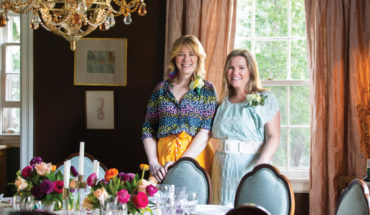A Raleigh food writer pays homage to the classic Southern standby.
by Debbie Moose
Eggs have been symbols of rebirth and renewal for centuries, which puts them at the center of spring holidays such as Passover and Easter. And to my mind, there’s no finer example of the art of the edible ovoid than that jewel of the South: the deviled egg.
Sure, you can fuss with eggs. An Instagram-popular recipe for Middle Eastern shakshuka involves simmering eggs in a spicy tomato-and-onion stew. That’s more effort than I can generally muster in the mornings, particularly pre-coffee. You can strain a wrist muscle trying to neatly turn over an omelet.
Generations of kids were needlessly forced to tiptoe around while soufflés were baking — including my husband, whose mother accused him of making her soufflé fall by walking through the kitchen with his giant teenage feet. Completely untrue, according to cooking science, but it left him with a fear of soufflés.
However, the simple perfection that is the deviled egg is within everyone’s grasp, and it uses ingredients most have right at home. It’s truly a snack of the people, and has never been even theoretically affected by someone’s size-13s.
Deviled eggs are found all over the country. But as it is with college football and humidity, no one does deviled eggs like the South. For generations, battles for bragging rights have been fought at family reunions, church suppers, and tailgates, via surreptitious glances to see whose platter is emptying the fastest. The winner earns the right to smugly lord over their cousins and neighbors until the next showdown.
For my mother’s generation, deviled egg plates — those glass or china platters with oval indentations that make perfect settings for the savory gems — were standard wedding gifts. Several years ago, I met a Morehead City woman who had collected more than 800 deviled egg plates; she was going for a Guinness World Record. After the plates took over the living room, her husband built an extension onto the house just to display the overflow.
I have a mere twelve plates. If my mother ever received a deviled egg plate, it was never used. She hated eggs, and deviled eggs in particular, so she didn’t make them. In fact, the only time I remember her hard-cooking eggs was to dye at Easter and lose in the yard.
One of nature’s paradoxes is how parents can end up with children of completely opposite temperament and interests from themselves. So it was with me: born into a deviled egg-deprived home, they were all I could think about. I looked forward to visiting my grandmother, my one regular source for deviled eggs, and devouring her silky smooth, mustard-tart creations. Some teenagers smoked pot to rebel; I experimented with mayonnaise and pickle relish.
To fuel my obsession, I wrote an entire cookbook on deviled eggs. I learned minutiae of egg anatomy (peeling is easier if you start at the big end, where an air pocket is); how to get the yolk exactly in the center of the white (store the carton of uncooked eggs on its side in the fridge); and why they’re called deviled eggs (early recipes used spicy ingredients, hence the term “deviling”).
The deviled egg itself has been reborn in restaurant kitchens, as small plates took over restaurant menus — possibly because their combination of intense flavor and rich creaminess creates a satisfying small bite.
That’s great — but I have a message to chefs who put an odd number of eggs on a plate for two people to share: don’t. Anyone who fights this Southern woman for the last deviled egg will always lose, and I’d like to keep my friends.
Click here for Debbie Moose’s Greek spin on the deviled egg.
Debbie Moose is the author of seven cookbooks, including her newest from University of North Carolina Press, Carolina Catch: Cooking North Carolina Fish and Shellfish from Mountains to Coast.





Pingback: 20+ Things to do in April in and around Raleigh - WALTER Magazine